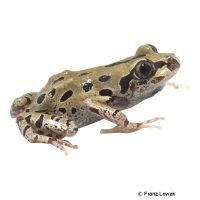Senegal Running Frog (Kassina senegalensis)
| Senegal Running Frog Kassina senegalensis | |
|---|---|
| Name | Senegal Running Frog |
| Name Lat. | Kassina senegalensis |
| Family | African Reed Frogs |
| Family lat. | Hyperoliidae |
| Order | Frogs & Toads |
| Order lat. | Anura |
| Origin | Africa |
| Habitat | Savanna |
| Diet | Small live insects |
| Humidity | 70-100 % |
| Behavior | Peaceful |
| Keeping | Pair |
| Care Level | Easy |
| Breeding | Moderately difficult |
| Housing | Humid terrarium |
| Life Span | 5-10 years |
| Protection | No |
| Metric Units | |
| Size | 4 cm |
| Temperature | 25-30 °C |
| Housing Size | 40 x 30 x 45 cm |
| US Units | |
| Size | 1.6" |
| Temperature | 77-86 °F |
| Housing Size | 15" x 10" x 20" |
Distribution and habitat
The distribution range of the nocturnal Senegal Striped Frogs, which live close to the ground, extends from Senegal via Cameroon and Tanzania to South Africa. They inhabit savannahs, bush steppes, forest edges, but also cultivated land always near temporary or perennial pools with reed growth.
Maintenance
For 1 animal the minimum area of the terrarium is 1,200 cm², for 2 animals 2,000 cm² with a minimum effective height (measured without substrate) of 35 cm. This corresponds to a base area of e.g. 40 x 30 cm or 50 x 40 cm for two animals. The terrarium should be placed in a quiet place without sunlight. You need a terrarium with a substrate of loose, absorbent, non-rotting substrate such as sand-peat mixture, coconut fibers or sphagnum moss with a drainage, plus pieces of bark, flat stones, strongly branched branches, preferably entwined with climbing plants, a dense planting (e.g. Tradescantia, Ficus, Hoya, Bromeliads) and a shallow water basin. Potted plants that can be easily removed for cleaning are advantageous. At least twice a day, except during seasonal dry periods, the inside of the terrarium must be finely sprayed with water (humidity), but a rain or mist system is better.
| Temp. day: 25-30 °C | Temp. night: 22-24 °C | Humidity: 70-100 |
The lighting duration must be 10-14 hours depending on the season. Daylight fluorescent tubes with low UV content are very suitable. During the seasonal dry period (3-5 months) the humidity is reduced to 50-80 %.
Diet
The diet consists of live, small worms and insects, such as ants, spiders, micro crickets, tiny grasshoppers and crickets, springtails, enchytraea and drosophila. After a period of habituation (feeding with tweezers), special ready-made food for insectivores is often accepted. Food should be offered to adult animals 2-3 times per week, young animals must be fed daily. It is important to add minerals and vitamins regularly (e.g. by dusting the feed animals). The quality of the feed animals can be upgraded by feeding overripe fruit and honey water
A varied diet promotes health and prevents deficiency symptoms.
Reproduction and breeding
Males and females can hardly be distinguished externally. Males remain slightly smaller.
After the rainy season, the female, which is ready to spawn, is taken in the mating grip (amplexus) by the male and lays about 600 solid-shelled eggs in clumps mostly on plants in shallow standing waters. Depending on temperature, the larvae (tadpoles) hatch after about 6 days. They initially filter microorganisms from the water and later eat animal and plant food. After about 90 days the transformation (metamorphosis) is completed and the frog leaves the water.
Life expectancy can be up to 10 years.
Important
Kassina senegalensis are also called racing frogs, because they do not move hopping, but running.
Before purchasing, a terrarium should be prepared that meets the species-specific needs. Good ventilation without drafts is necessary, as well as equipment for measuring temperature and humidity. The lighting has to correspond to the species-specific day-night rhythm and should be placed in such a way that the animals cannot injure themselves. The terrarium should be locked in such a way that neither unauthorized persons can open it nor the animals can escape. Special attention must be paid to thorough hygiene and impurities must be removed regularly
Further literature can be found in your pet store.
References
Text: petdata; Image: Franz Lowak
Source: VDA & DGHT (2006): Haltungsrichtlinien für die Haltung von Anuren; ENGELMANN (2006): Zootierhaltung - Tiere in menschlicher Obhut: Reptilien und Amphibien, Harri Deutsch Verlag
- Gemäß § 21 Abs. 5 Tierschutzgesetz idgF
